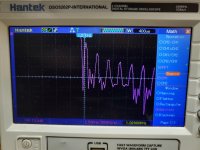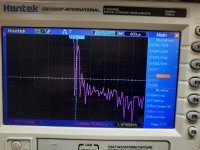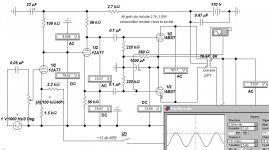When I switch to the sine wave, the peaks drop right down into the noise. The only thing I changed between these two images was from square to sine wave on the tone generator. That other mode was the only way I could get any sort of definition. I believe it was "Blackman." These two are both in "Bartlett." My scope may just not be well suited to this.
Attachments
Last edited:
Well, setting the scope and FFT can be tricky. Much more so than a real spectrum analyzer like an old Tektronix 7L5.
If I was there, I would be able to optimize the measurement to the limits of the scope and its FFT.
A skilled operator might be able to get better than 48dBc on a pure sine wave with that scope and FFT.
I used to get down to -54 dBc on an inexpensive scope and FFT.
But of course, the signal source was far better than -54dBc to get that measurement.
If I was there, I would be able to optimize the measurement to the limits of the scope and its FFT.
A skilled operator might be able to get better than 48dBc on a pure sine wave with that scope and FFT.
I used to get down to -54 dBc on an inexpensive scope and FFT.
But of course, the signal source was far better than -54dBc to get that measurement.
I've gained a bit of experience the last year in using a DSO and FFT functions.
Generally the output units are dBm or dBV, so the root sum squared calculation, if used, needs to take that into account (10log for dBm, 20log for dBV)
My 8 bit scope, has about 72dB dynamic range, uses something called Equivalent Time Sampling, which pretends the scope is 12bit resolution, to increase the dynamic range to this level.
Flat top or Von Hann windowing is probably the most appropriate for this usage, measuring the amplitude of harmonic peaks.
I am lucky enough to have been able to access another old, but higher quality DSO to check results corroborate - thankfully they do.
However, it is unlikely that accuracy can be maintained below about 0.25 to 0.5% THD, and this is probably the limits of an 8 bit DSO.
If you have a true 12 bit DSO then that can be bettered, all selling being equal.
Use of Averaging samples, which is on some scopes and not others, will help to clean up the noise floor and reveal the offenders.
Another good idea, if you have a signal generator with a Sync outputs is to use this to trigger the FFT, using the ext trig input.
Sadly my experience of mobile app based sine wave generators is similar to yours, they're not great.
Generally the output units are dBm or dBV, so the root sum squared calculation, if used, needs to take that into account (10log for dBm, 20log for dBV)
My 8 bit scope, has about 72dB dynamic range, uses something called Equivalent Time Sampling, which pretends the scope is 12bit resolution, to increase the dynamic range to this level.
Flat top or Von Hann windowing is probably the most appropriate for this usage, measuring the amplitude of harmonic peaks.
I am lucky enough to have been able to access another old, but higher quality DSO to check results corroborate - thankfully they do.
However, it is unlikely that accuracy can be maintained below about 0.25 to 0.5% THD, and this is probably the limits of an 8 bit DSO.
If you have a true 12 bit DSO then that can be bettered, all selling being equal.
Use of Averaging samples, which is on some scopes and not others, will help to clean up the noise floor and reveal the offenders.
Another good idea, if you have a signal generator with a Sync outputs is to use this to trigger the FFT, using the ext trig input.
Sadly my experience of mobile app based sine wave generators is similar to yours, they're not great.
Last edited:
PP 6BX7 Version using Dukane OPT
This is a much better match, about One Watt of audio in Class A. I did bench testing on the 6BX7 about a year ago, it easily managed 3 Watts into a Hammond 125E OPT running on a 280V supply.
Fix any errors & problems first, then apply NFB.🙂
This is a much better match, about One Watt of audio in Class A. I did bench testing on the 6BX7 about a year ago, it easily managed 3 Watts into a Hammond 125E OPT running on a 280V supply.
Fix any errors & problems first, then apply NFB.🙂


